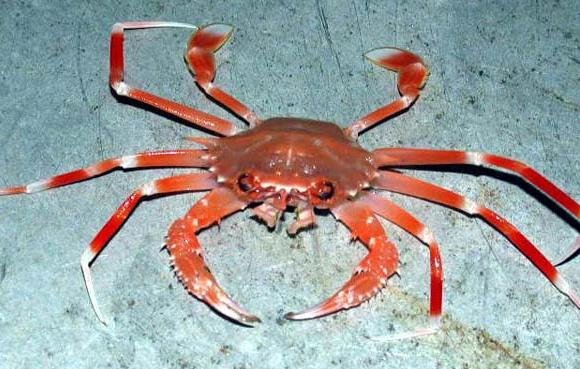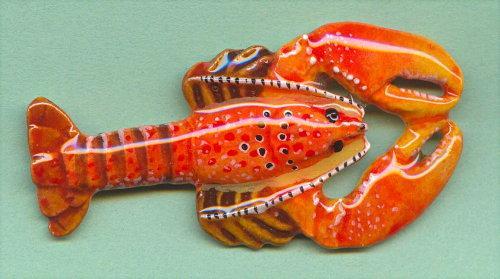Barnacles,
Crabs &
Lobsters, and Horseshoe "Crabs"
(Fr-bernacle, crabe,
homard; Ger- Entenmuschel/Seepocken-?, Krebbe,
Hummer;
Nor-andeskjell, krepsdyr, hummer;
Rus-щипцы, краб,
рак)
A. Barnacles. Relatively large one
(height - 3.3 cm), upon which others have been deposited, found on
beach at Port Aransas, Texas. (© photo by Dick Dietrich)
B. Crab. "This crab [size not
indicated] was collected from deep in the ocean. The red color
helps protect it from predators." (NOAA as the source
Ocean explorer) (photo from
National Oceanic and Atmospheric
Administration, U.S. Department of Commerce,
http://oceanexplorer.noaa.gov/)
C. Lobster replica (length ~ 4.5 cm).
“hand-painted pewter ... [to] use as a pin, tie tack, hat pin or lapel
pin.” Fashioned in Washington and Idaho by a team of U.S.
artists. (© photo
courtesy of Sheryl Todd, http://www.tapirback.com/
)
D.
Horseshoe
"crabs." Bottom
(length ~18cm) and top of skeletons,
collected by Iona Whitley
from shore of Delaware Bay. (© photo courtesy
Patricia A. Weeg, http://www.globalclassroom.org/)
DESCRIPTION: Phylum,
Arthropoda;
class, Crustacea: This class includes barnacles (subclass
Cirripedia), the
hard parts of which comprise several calcite
(CaCO3) plates, and crabs
and lobsters
(both subclass, Malacostraca), the exoskeletons of
which are chitin. In addition, this entry includes horseshoe
"crabs" (Limulus
polyphemus Linnaeus, 1758) --
Phylum,
Arthorpoda; class, Merostomata; subclass,
Xiphosura -- which have
keratinous exoskeletons.
Colors - Barnacles: White, gray, brown,
reddish, purplish.
Crabs: diverse
hues of red, orange, yellow, green, blue and purple and/or white,
tan or brown; most have skeletons with different colors typical
of different sections, and some have, for example, some multicolored
and/or patterned (e.g.,
streaked and/or spotted) surfaces. Lobsters: "A live lobster is
greenish-black on top and orange below, with
accents of blue on the joints of its claws. That is because a lobster's
shell is composed of three pigments: red, blue, and yellow. ¶ When
one or more of these pigments are missing at birth, a lobster
may be red, blue, albino (white), or calico (dark with yellow spots).
... Except for
albinos, all the
color variations of lobsters turn red when they are
cooked." (Gulf of Maine Aquarium, 1997) -- So much for the analogy "red
as a lobster."
Horseshoe "crabs":
carapaces
tend to be dark to light brown or greenish.
H. Barnacles: ~3.
Others: ~2½ << an example of
plate-like keratin-rich material.
S.G. Barnacles: 2.65 - 2.84.
Others: ~1.29 << an example of
plate-like keratin-rich material.
Light transmission - Barnacles: semitranslucent
to opaque. Others -
transparent to semitranslucent
Luster - Barnacles: dull to pearly.
Others: outside, subvitreous to waxy; inside, dull
to porcelaneous
Breakage - irregular
(brittle)
Miscellaneous - barnacles' hard parts
consist of six or more relatively thick plates, the overall arrangement
of which roughly resembles a volcano (i.e.,
a truncated
cone), and they commonly have macroscopically visible growth bands
more-or-less parallel to the base (Figure A); the plates, which
consist largely of calcite,
effervesce with dilute HCl.
OTHER NAMES: Many scientists
consider it necessary to enclose crab in quotation marks when
referring to horseshoe crabs -- see first paragraph of REMARKS.
- Horsefoot
- designation given horseshoe "crabs" in some places, including
professional literature -- e.g.,
in the Preface of the
monograph Biomedical applications of
the horseshoe
crab. (Cohen, 1979).
- King crab - Some people refer to the
horseshoe "crab" as king crab; this use can be misleading because
the
designation is also applied widely to the Alaskan King crab (subclass, Malacostraca) -- a true crab --
without the Alaskan adjective.
USES: Barnacles of the acorn type
have found use as decorative accessories (in some cases dyed) in
aquaria. Exoskeletons of crabs, lobsters and horseshoe
"crabs" are frequently used as decorative pieces in, for example,
restaurants that feature seafood.
The
California spiny
lobster Panulirus interruptus (J.W.
Randall, 1840) of the eastern
Pacific -- range, San Luis Obispo, California to Rosalia Bay, Baja
California -- and the American
lobster (Homarus americanus H.
Milne-Edwards, 1837)
of New England and the Canadian maritime provinces, though having
quite different
appearances are both used as decorations in restaurants that feature
their meat. Among other things, spiny lobsters lack the large
claws
that are characteristic of the American lobster, and, as their
common
name
indicates, they have scattered spines over much of their bodies.
The appearance of the
spiny lobster (see Colla, 2006), however, appears
to have led
to its less widespread use as a decoration in
the decorative
arts and
crafts as well as in restaurants; this despite
the fact that, at least in my
opinion, both lobsters are equally tasty. Whatever,
both of these lobsters and horseshoe
"crabs" have
found widespread use as decorations.
Not a
decorative but nonetheless a noteworth use: "Limulus [the horseshoe
"crab"] was well-known to
American Indians; coastal tribes used the long serrated telson as
a fish-spearhead." (Shuster, 1979, p. 3)
OCCURRENCES & NOTEWORTHY LOCALITIES:
Barnacles live attached to hard
surfaces such as rocks, docks, ship hulls, etc.
at
virtually all latitudes and at depths ranging from intertidal flats to
deep sea zones. Crabs, if one considers all
the numerous species, have a nearly worldwide distribution with their
habitats including diverse marine, freshwater and semi-terrestrial
environments.
Lobsters are benthic
(bottom-dwelling) and live in marine waters that have certain
temperature ranges here and there around the world; an
example is the North American Atlantic coastal area from North Carolina
north to the Strait of Belle Isle between Newfoundland and the
mainland, with the greatest abundance apparently within the Gulf
of Maine (Maine, New Brunswick and Nova Scotia production accounts for
a large percentage of marketed lobsters). Horseshoe "crabs" are benthic,
with Limulus polyphemus
Linnaeus,
1758
described
as "an estuarine species with anadromous tendencies ... [that] as they
grow larger ... move further and further away from their natal area
into deeper water, many going out onto the continental shelf" (Shuster,
1979, p.30); they occur sporadically on the continental shelf
and in estuaries along the western Atlantic coast from the
Yucatán
peninsula northward to Taunton Bay, which is north of Mt. Desert
Island, Maine, and "In May and June, the beaches of Delaware Bay
are visited by the largest spawning population of Limulus along the Atlantic coast." (op.
cit., p.20). An
outline map showing the general distribution of the three western
Pacific-Indian Ocean species as well as the western Atlantic horseshoe
"crabs" is given by Sekiguchi and Nakamura (1979, p.39).
REMARKS: . Application of the
word barnacle to
these crustaceans appears to have an origin
that is analogous to the old poser "which came first the chicken or the
egg?". Harper provides the following: "... Often [suggested as]
derived from a Celtic source
(cf. Bret[on?]). bernik 'kind of
shellfish'), but the application to the goose predates that of the
shellfish in Eng[lish]. The goose nests in the Arctic in summer and
returns to Europe in the winter, hence the mystery surrounding its
reproduction. It was believed in ancient superstition to hatch from
barnacle's shell, possibly because the crustacean's feathery stalks
resemble goose down." (Harper, 2001). Crab appears to be from Old English crabba with possible roots to Low Germ Krabben (to scratch or claw)? Lobster is thought to come from Middle English lopster, perhaps via Old English lobbe (spider) and/or Latin locusta (locust) -- both possible roots, if
pertinent, are hypothesized to be based on physical resemblances.
The designation horseshoe crab is
considered by many professional biologists to be misleading because the
animal is not a crustacean and consequently they contend not a crab
(although crab is a common rather than a scientific name);
indeed, when using the common name, they use horseshoe "crab." That "problem"
notwithstanding, the horseshoe
designation is
based on the shape of the animal's shell.
The
importance
of the horseshoe "crab" so far as medical research involving eyes is
well
known because of H.K. Hartline's work that led to his receiving the
Nobel Prize in the late 1960s. (Hartline began the investigations
that led to his understanding of vision systems by studying the nerves
that carry impulses from horseshoe crabs' eyes to their brains;
the fact that those nerves are relatively large in horseshoe crabs
meant that they could be manipulated macroscopically; ...)
In addition, though not
as widely
known, "[t]he blood of the
horseshoe crab provides a valuable medical product critical to
maintaining the safety of many drugs and devices used in medical care.
A protein in the blood called Limulus Amebocyte Lysate (LAL) is used by
pharmaceutical and medical device manufacturers to test their products
for the presence of endotoxins, bacterial substances that can cause
fevers and even be fatal to humans." (Maryland DNR,
1995-2005).
“Commercial
interest in chitin has slowly increased in the past several years
because chitin is strong, nonallergenic, and biodegradable.
Chitin can, for example, be solubilized and then reformed into fibers,
which can then be used in making fabrics and surgical sutures."
(Pechenik, 2005, p.330).
One of the 12 signs of the zodiac has a crustacean as its sign: Cancer,
a crab, for June 22 through July 22; another has
Scorpio, the scorpion, for October 24 through November 22, which is not
a crustacean but is of the same subphylum (Chaliceriformes) as the
horseshoe crabs.
-- An aside: Although the lyrics
of "Barnacle Bill the sailor man" seem hardly worth a thought,
here or elsewhere, as a fan of Bix Beiderbecke's cornet
artistry, I
cannot pass up this chance to mention his solo on this tune with the Hoagy
Carmichael group. -- It was one of
Bix's last recorded solos (May 21, 1930). As Sudhalter and Evans
(1947, p.304) note: "[Bix] turns on the old fire for a 20-bar,
up-tempo
outburst
on 'Barnacle Bill.'"
SIMULANTS:
None
so far as I know.
REPLICAS: Diminutive
and/or large replicas (an admitted oxymoronic phrase) of
crabs, lobsters and horseshoe "crabs," many of which are stylized, have
been used as functional things -- e.g.,
can
openers, Christmas tree
ornaments, "collectibles," jewelry boxes, lamps, paper weights and salt
and pepper shakers --
as well as in jewelry. Most of these consist
largely of some ceramic,
glass, gold,
silver (including sterling), steel, brass, pewter, an unidentified
metal or alloy, OR some combination of two or more of these
materials; some are bejeweled
and/or
enameled or
even painted or otherwise colored
to resemble the animal more closely (Figure C). In addition,
larger-than-life-size
replicas, commonly fashoined from bronze, have been produced and are
marketed for placing in homes or
gardens.
R.V.
Dietrich © 2015
Last update: 28 January 2014
web page created by Emmett Mason


